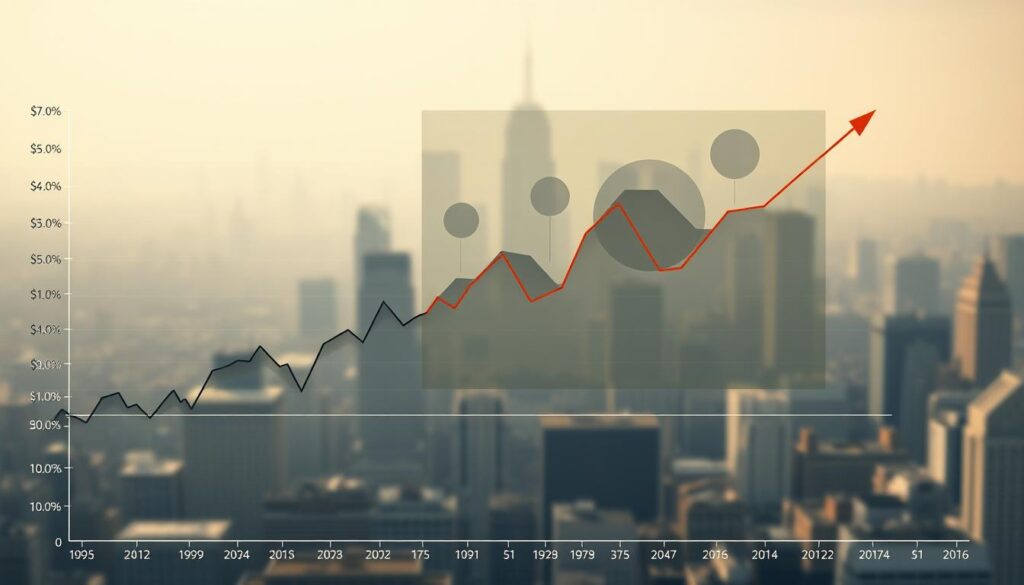Understanding how interest rates influence your investments is crucial for making informed decisions. Central banks set interest rates, which in turn affect the overall economy and various investment vehicles.
Interest rates play a significant role in shaping your investment strategy. They can impact the attractiveness of different investments, such as stocks, bonds, and real estate.
By grasping how interest rates work, you can better navigate the financial markets and make more informed investment choices.
Key Takeaways
- Interest rates significantly influence investment decisions.
- Central banks control interest rates, affecting the economy.
- Different investments are impacted by interest rate changes.
- Understanding interest rates can improve your investment strategy.
- Interest rates can affect the attractiveness of various investment vehicles.
Understanding Interest Rates and Their Significance
The significance of interest rates cannot be overstated, as they affect not just borrowing costs but also the returns on investments. Interest rates are a critical component of the financial landscape, influencing the attractiveness of various investments.
Interest rates are determined by central banks, such as the Federal Reserve in the United States, through monetary policy decisions. These decisions are based on economic indicators like inflation, unemployment rates, and GDP growth. When the economy is growing too quickly, central banks may raise interest rates to prevent overheating and control inflation. Conversely, during economic downturns, they may lower interest rates to stimulate growth.
Interest rates have a direct impact on investment returns. For instance, when interest rates rise, the returns on fixed-income investments like bonds and CDs increase, making them more attractive to investors. On the other hand, higher interest rates can make borrowing more expensive, potentially slowing down economic growth and affecting stock market performance.
The correlation between interest rates and investments is complex. Investors need to understand how changes in interest rates can affect different asset classes. For example, real estate investments are sensitive to interest rates because mortgage rates are directly influenced by changes in interest rates. When interest rates rise, mortgage rates tend to increase, which can reduce demand for housing and impact property values.
| Investment Type | Effect of Rising Interest Rates | Effect of Falling Interest Rates |
|---|---|---|
| Bonds | Increased attractiveness due to higher yields | Decreased attractiveness due to lower yields |
| Stocks | Potential decline due to higher borrowing costs | Potential increase due to lower borrowing costs |
| Real Estate | Higher mortgage rates can reduce demand | Lower mortgage rates can increase demand |
Understanding the significance of interest rates and their impact on different investments is crucial for making informed investment decisions. By staying informed about interest rate trends and their potential effects on various asset classes, investors can better navigate the financial markets and achieve their investment goals.
How Interest Rates Influence Stock Market Performance
Understanding the relationship between interest rates and stock prices is essential for investors seeking to maximize their returns. The stock market and interest rates have a complex interplay, where changes in interest rates can significantly impact stock prices.
Generally, lower interest rates make borrowing cheaper, potentially boosting stock prices as companies can invest more in growth opportunities. Conversely, higher interest rates can make borrowing more expensive, potentially dampening stock prices as companies face increased costs.
The Relationship Between Rates and Stock Prices
The relationship between interest rates and stock prices is intricate. When interest rates are low, investors often seek higher returns in the stock market, driving up stock prices. On the other hand, high interest rates can attract investors to bonds and other fixed-income investments, potentially leading to a decrease in stock prices.
Key factors influencing this relationship include:
- Economic growth prospects
- Inflation expectations
- Monetary policy decisions
Investors must consider these factors when developing investment strategies in changing rates. For instance, during periods of rising interest rates, investors may need to adjust their portfolios to mitigate potential losses.
Historical Trends of Interest Rates and Stocks
Historically, the relationship between interest rates and stock prices has been evident during various economic cycles. For example, during the 2008 financial crisis, interest rates were lowered to stimulate economic growth, leading to a significant boost in stock prices.
The following table illustrates the historical trends of interest rates and stock market performance over the past few decades:
| Year | Interest Rate | Stock Market Performance |
|---|---|---|
| 2000 | 6.5% | -10% |
| 2008 | 1.0% | -38.5% |
| 2015 | 0.25% | 1.4% |
| 2020 | 1.55% | 16.1% |
By examining historical trends and understanding the dynamics between interest rates and stock prices, investors can make more informed decisions when managing investments during rate changes.
Bonds and Interest Rates: A Double-Edged Sword
Bonds, often seen as a safe haven, are heavily impacted by fluctuations in interest rates, making them a double-edged sword for investors. The value of bonds is inversely related to interest rates, meaning as rates rise, the value of existing bonds typically falls.
This dynamic is crucial for investors to understand, as it directly affects the attractiveness of bonds in their portfolios. The interest rate risk in investments is a significant consideration, particularly for those relying on fixed-income securities.
What Happens When Rates Rise?
When interest rates rise, newly issued bonds offer higher yields, making existing bonds with lower yields less attractive. This can lead to a decrease in the market value of existing bonds. The impact of the Federal Reserve on investments is substantial, as its decisions on interest rates can trigger such shifts.
| Interest Rate Change | Effect on Existing Bonds | Investor Action |
|---|---|---|
| Rates Rise | Value Decreases | Consider Selling or Holding |
| Rates Fall | Value Increases | Consider Buying or Holding |
Why Some Investors Prefer Bonds Over Stocks
Despite the risks, some investors prefer bonds over stocks due to their relatively stable returns. Bonds offer a regular income stream, which can be particularly appealing in a volatile market or during retirement.
The preference for bonds is also influenced by the perceived safety they offer compared to the potentially higher but more volatile returns from stocks. Investors must weigh the trade-offs between risk and return when deciding between bonds and other investment vehicles.
Real Estate Investments in a Changing Rate Environment
Interest rate shifts can dramatically alter the landscape for real estate investors, influencing mortgage rates and overall market activity. As such, understanding the dynamics between interest rates and real estate is crucial for making informed investment decisions.
The Mortgage Rate Connection
Mortgage rates are closely tied to interest rates, and changes in these rates can significantly affect the cost of borrowing for potential homebuyers and investors. When interest rates rise, mortgage rates typically follow suit, making it more expensive to purchase or refinance a property.
The impact on real estate investments can be substantial, as higher mortgage rates can reduce demand for properties, potentially leading to a decrease in property values. Conversely, when interest rates fall, mortgage rates often decrease, stimulating demand and potentially driving up property values.

Impact on Property Values
The value of real estate investments is directly influenced by changes in interest rates. As rates fluctuate, so too does the attractiveness of investing in real estate. For instance, in a low-interest-rate environment, real estate becomes more attractive due to its potential for higher returns compared to other investments.
| Interest Rate Environment | Effect on Mortgage Rates | Impact on Property Values |
|---|---|---|
| Rising Interest Rates | Increase in Mortgage Rates | Potential Decrease in Property Values |
| Falling Interest Rates | Decrease in Mortgage Rates | Potential Increase in Property Values |
In conclusion, the relationship between interest rates and real estate investments is complex and multifaceted. Investors must remain vigilant and adapt their strategies to navigate the changing interest rate environment effectively.
Interest Rates and Consumer Behavior
Interest rates play a crucial role in shaping consumer behavior, affecting both spending and saving decisions. When interest rates are low, consumers are more likely to borrow money to purchase big-ticket items, such as cars or homes, because the cost of borrowing is lower.
Conversely, high interest rates make borrowing more expensive, which can lead to decreased consumer spending. Understanding these dynamics is essential for investors and policymakers alike.
Spending Patterns During Low vs. High Rates
During periods of low interest rates, consumers tend to increase their spending on durable goods and luxury items. This is because lower rates reduce the cost of financing for these purchases.
- Increased spending on big-ticket items like cars and homes
- Higher demand for consumer durables and luxury goods
- Potential for economic growth due to increased consumption
In contrast, high interest rates lead to decreased spending as borrowing becomes more costly. Consumers may delay or forego large purchases to avoid higher interest charges.
The Effect on Savings and Investments
Interest rates also have a significant impact on savings and investment decisions. Higher interest rates typically encourage saving by offering higher returns on deposits.
- Higher returns on savings accounts and CDs
- Increased attractiveness of fixed-income investments like bonds
- Potential shift from equity investments to debt securities
On the other hand, low interest rates may discourage saving and encourage investment in riskier assets, such as stocks, in search of higher returns.
Key considerations for investors include: understanding the current interest rate environment, assessing the impact on different asset classes, and adjusting investment strategies accordingly.
Risk Assessment: Higher Rates Mean Higher Risks
As interest rates rise, the landscape of investment risk changes dramatically. Higher interest rates can lead to increased borrowing costs, potentially reducing the attractiveness of certain investments such as stocks and real estate. Understanding these dynamics is crucial for investors looking to navigate the changing financial landscape.
Evaluating Investment Opportunities
When evaluating investment opportunities in a high-interest-rate environment, it’s essential to consider the impact of these rates on different asset classes. For instance, stocks may become less appealing due to higher borrowing costs for companies, potentially affecting their profitability. On the other hand, investments like bonds may become more attractive as they offer higher yields to compensate for the increased risk.
Key Considerations for Investors:
- Assess the debt levels of companies before investing in their stocks.
- Consider the potential for higher returns from bonds and other fixed-income securities.
- Evaluate the impact of higher interest rates on real estate investments, including mortgage rates and property values.
Diversifying Your Portfolio
Diversification is a critical strategy for managing risk in a high-interest-rate environment. By spreading investments across different asset classes, investors can mitigate the potential negative impacts of rising rates on their portfolios. This might involve allocating investments across stocks, bonds, real estate, and other assets to achieve a balanced risk profile.

A diversified portfolio can help investors navigate the challenges posed by higher interest rates. The following table illustrates a simple diversification strategy across different asset classes:
| Asset Class | Low Interest Rate Environment | High Interest Rate Environment |
|---|---|---|
| Stocks | High Potential for Growth | Higher Borrowing Costs May Reduce Attractiveness |
| Bonds | Lower Yields, Less Attractive | Higher Yields, More Attractive |
| Real Estate | Lower Mortgage Rates, More Affordable | Higher Mortgage Rates, Less Affordable |
By understanding the implications of higher interest rates on different investments and diversifying their portfolios accordingly, investors can better manage the associated risks and potentially capitalize on new opportunities.
Global Economic Factors Influencing Interest Rates
Interest rates are not set in isolation; they are shaped by a multitude of global economic factors and events. The global economy is interconnected, and changes in one region can have far-reaching effects on interest rates worldwide.
How Global Events Affect the U.S. Market
Global events, such as economic downturns, political instability, and trade wars, can significantly impact the U.S. market. For instance, during times of global economic uncertainty, investors often seek safe-haven assets, such as U.S. Treasury bonds, driving down interest rates.
The U.S. market is also affected by economic indicators from other countries, such as GDP growth rates and inflation data. These indicators can influence the Federal Reserve’s decisions on interest rates, as they provide insight into the overall health of the global economy.
The Role of Central Banks
Central banks, like the Federal Reserve in the United States, play a crucial role in setting interest rates. They use monetary policy tools, such as open market operations and reserve requirements, to influence the money supply and, subsequently, interest rates.
The Federal Reserve’s decisions on interest rates are influenced by a range of factors, including inflation data, employment rates, and global economic trends. By adjusting interest rates, the Fed aims to promote maximum employment and price stability.
| Global Economic Factor | Impact on Interest Rates | Effect on U.S. Market |
|---|---|---|
| Economic Downturns | Decrease | Increased demand for safe-haven assets |
| Trade Wars | Increase | Market volatility |
| Global Inflation | Increase | Higher borrowing costs |
Understanding the complex interplay between global economic factors and interest rates is essential for investors seeking to navigate the ever-changing economic landscape.
Long-Term vs. Short-Term Investments: Strategies
Understanding the nuances of long-term versus short-term investments is crucial for developing effective investment strategies in varying interest rate environments. The decision to opt for long-term or short-term investments depends on several factors, including the prevailing interest rates, economic conditions, and individual financial goals.
Investors must consider their risk tolerance and investment horizon when choosing between long-term and short-term investments. Long-term investments typically involve a higher degree of risk but also offer the potential for greater returns over time. In contrast, short-term investments are generally less risky but may provide lower returns.
Best Practices in a High-Interest Environment
In a high-interest rate environment, investors can benefit from strategies that maximize returns while minimizing risk. One effective approach is to allocate a portion of the investment portfolio to high-yield savings accounts or short-term bonds that take advantage of the higher interest rates.
- Consider investing in short-term, high-quality bonds that mature in a few years, allowing you to reinvest at potentially higher rates.
- Utilize high-yield savings accounts or money market funds that offer competitive interest rates.
- Diversify your portfolio by including a mix of low-risk investments, such as Treasury bills and commercial paper.
Rebalancing Your Portfolio Over Time
Rebalancing your investment portfolio is essential to ensure that it remains aligned with your financial goals and risk tolerance, especially in changing interest rate environments. Regular portfolio rebalancing can help you capitalize on opportunities and mitigate potential losses.
| Investment Type | Low-Interest Rate Environment | High-Interest Rate Environment |
|---|---|---|
| Stocks | Potentially higher returns due to increased consumer spending | May experience volatility due to higher borrowing costs |
| Bonds | Lower yields; consider alternative fixed-income investments | Higher yields; attractive for income-seeking investors |
| Real Estate | Increased demand due to lower mortgage rates | Higher mortgage rates may reduce demand |
By understanding the impact of interest rates on different investment types and regularly rebalancing your portfolio, you can develop effective investment strategies that adapt to changing economic conditions.
The Role of Inflation in Interest Rate Decisions
Inflation plays a significant role in shaping interest rate policies, which in turn affect your investments. Central banks often adjust interest rates in response to inflationary pressures, making it a critical factor for investors to consider.
Effects on Investment Returns
Inflation can erode the purchasing power of your investments, particularly those with fixed returns. For instance, if you hold a bond with a fixed interest rate and inflation rises, the real value of the interest payments decreases.
Managing investments during rate changes requires a nuanced understanding of how inflation impacts different asset classes. Stocks, for example, can be affected in various ways, with some companies benefiting from inflation due to pricing power, while others may struggle with increased costs.
Adjusting Your Investment Strategy
To mitigate the effects of inflation on your investments, consider diversifying your portfolio. This can include investing in assets that historically perform well during inflationary periods, such as real estate or commodities.
Another strategy is to invest in securities that offer protection against inflation, such as Treasury Inflation-Protected Securities (TIPS). These investments can help safeguard your portfolio against the erosive effects of inflation.
By understanding the relationship between inflation and interest rates, and by adjusting your investment strategy accordingly, you can better navigate the challenges posed by inflation and interest rate changes.
Making Informed Investment Decisions
Understanding the impact of interest rates on investments is crucial for making informed decisions. As discussed in the previous sections, interest rates significantly influence various asset classes, including stocks, bonds, and real estate. To navigate these complexities, investors must stay informed and adapt their strategies accordingly.
Essential Tools for Investors
Investors can leverage various tools and resources to stay ahead. Financial news platforms like Bloomberg and CNBC provide real-time updates on market trends and interest rate changes. Additionally, investment apps and robo-advisors offer personalized portfolio management and insights into interest rate impact.
The Challenge of Timing the Market
Timing the market is notoriously difficult, even for seasoned investors. While it’s tempting to try to predict interest rate fluctuations, a more effective approach often involves long-term strategies and diversification. By understanding the interest rate environment and its potential impact on investments, investors can make more informed decisions.
By staying informed and utilizing the right tools, investors can better navigate the complexities of interest rates and their impact on investments.

